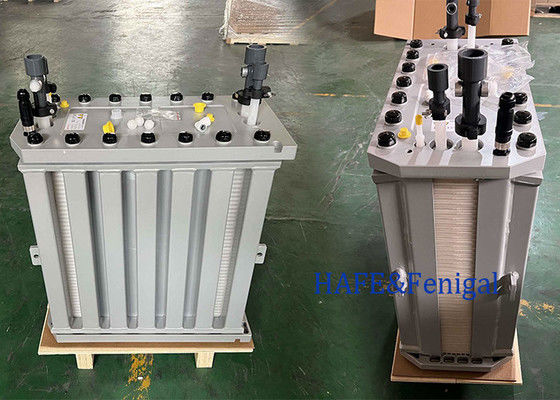Suez EDI Stacks Nominal Flow 7.0 M³/H VEOLIA EDI Modules E-Cell MK-7
Product Details:
| Place of Origin: | China |
| Brand Name: | VEOLIA |
| Certification: | CE |
| Model Number: | E-Cell MK-7 |
Payment & Shipping Terms:
| Minimum Order Quantity: | 1 pc |
|---|---|
| Price: | Negotiable |
| Packaging Details: | standard export packing |
| Delivery Time: | 5- 8 work days |
| Supply Ability: | 60000 Units per Month |
|
Detail Information |
|||
| Shipping Weight: | 165 Kg | Nominal Flow: | 7.0 M³/h (31 Gpm) |
|---|---|---|---|
| Flow Rate Range: | 5.0 – 9.0 M³/hr | Temperature: | 4.4–40˚C (40–104˚F) |
| Recovery: | Up To 97% | PH: | 4-11 |
| Voltage: | 0–400 VDC | Amperage: | 0-5.2ADC |
| Highlight: | edi electrodeionization in purified water system,edi in ro plant,edi electrodeionization in ro plant |
||
Product Description
Suez EDI Stacks 30cm X 61cm X 74cm Nominal Flow 7.0 M³/h VEOLIA EDI Modules E-Cell MK-7
E-Cell EDI Stack Features And Benefits
- Efficient production: It can produce high-purity water continuously and predictably, providing a stable high-quality water source for various industrial applications.
- Environmental protection and energy saving: By reducing the use of chemical agents and the discharge of harmful wastewater, it helps to protect the environment and save resources.
- Modular design: The modular technology can be matched with different numbers of modules to adapt to various water treatment requirements, providing strong support for the production of high-purity water in industries such as power generation, microelectronics, fine chemicals and pharmaceuticals.
- Technological innovation: Compared with traditional mixed bed technology, EDI technology can more effectively remove polluting ions in water and produce higher purity water through electric field action and ion exchange principle.
- Cost reduction: By reducing the operating voltage and simplifying the system design, E-Cell EDI Stack not only achieves the lowest operating energy consumption in the EDI market, but also reduces the investment cost of modules and system investment cost.
Quality Assurance
• CE, RoHS, CSA and EAC marked
• Manufactured in an ISO 9001 and ISO 14001 facility
• Certified with UKCA
• E-Cell MK-7 Stacks are Halal certified by the Islamic Food and Nutrition Council of America (IFANCA®)
| E-Cell MK-7 Stack Specifications | |
| Nominal Flow | 7.0 m³/h (31 gpm) |
| Flow Rate Range | 5.0 – 9.0 m³/hr |
| Shipping Weight | 165kg |
| Dimensions (width x height x depth) |
30 cm x 61 cm x 74 cm |
![]()
Notes:
1. Actual performance may vary depending on site conditions. Reference Winflows projection software to verify expected product water quality as well as the resistivity, sodium, and silica performance guarantees that are offered for the design conditions. To obtain boron or other guarantees, contact Veolia.
2. Inlet pressure is determined by the downstream pressure requirements for the product and concentrate streams, the choice of counter-current or co-current operation, and stack pressure drop.
3. At nominal flow and 25°C. Reference Winflows projection software to verify for design conditions.
4. Reference the Winflows projection software and the E-Cell Stack Owner’s Manual to verify feed water specifications for the design conditions.
5. TEA (ppm as CaCO3) - Total Exchangeable Anion, this represents the concentration of all of the anions present in the feed water including contributions from OH- , CO2 and SiO2. Winflows must be used to confirm the feed water TEA is acceptable at the specific applications’ operating conditions. Table value is at minimum flow and maximum temperature.
6. 1.0 ppm as CaCO3 feed water hardness limit applies to standard counter-current flow operation only. Allowable feed water hardness decreases to 0.1 ppm as CaCO3 in co-current flow operation.
7. Allowable silica limit decreases above 5 m3 /h flow. Allowable silica limit decreases to 0.5 ppm with feedwater hardness above 0.5 ppm as CaCO3.
8. The boron feed level is limited to 0.3 ppm as B whenever there is a silica guarantee requirement or resistivity guarantee requirement above 10 MOhm-cm, as higher boron levels could impact performance. Without these requirements the limit is 1.0 ppm boron.
9. Reverse Osmosis (RO) or equivalent feed water: RO provides EDI feed water that is substantially free of particulate matter, colloidal material and high molecular weight organic substances, which can foul ion exchange media. RO permeate quality is specified since EDI stacks contain packed beds of ion exchange medium that cannot be backwashed/fluidized to remove particulate matter. Systems with an open system between a RO system (or other source) and E-Cell (ex. tank, decarbonator) must be fitted with filters immediately preceding the E-Cell, to protect the E-Cell against contamination with particulate matter. Generally, a 5 µm absolute or 1 µm nominal filter will be acceptable.
10.APHA - color standard/scale named for the American Public Health Association and defined by ASTM D1209.Veolia Water Technologies
Want to Know more details about this product







